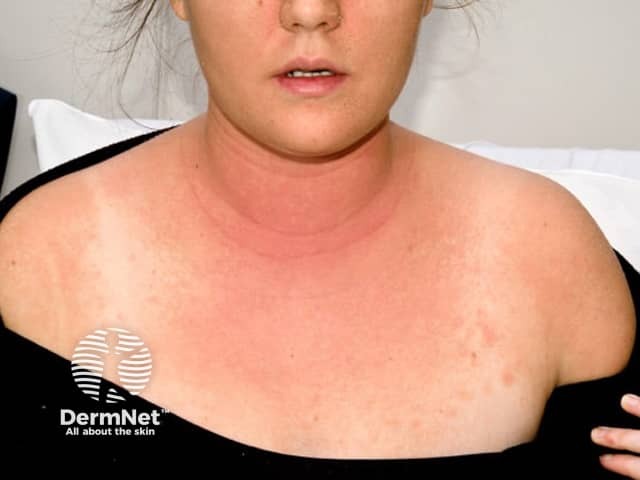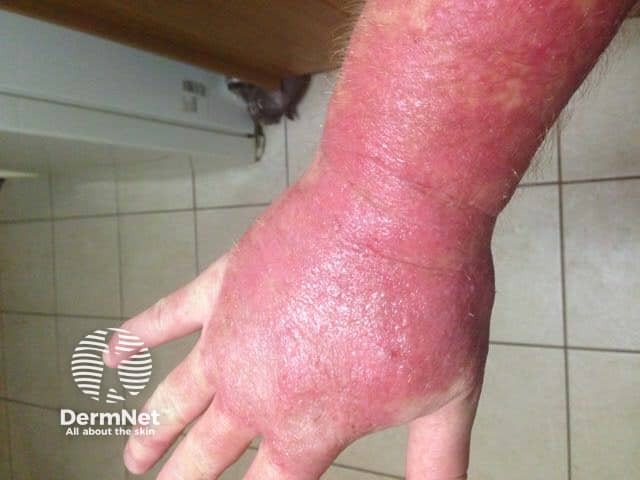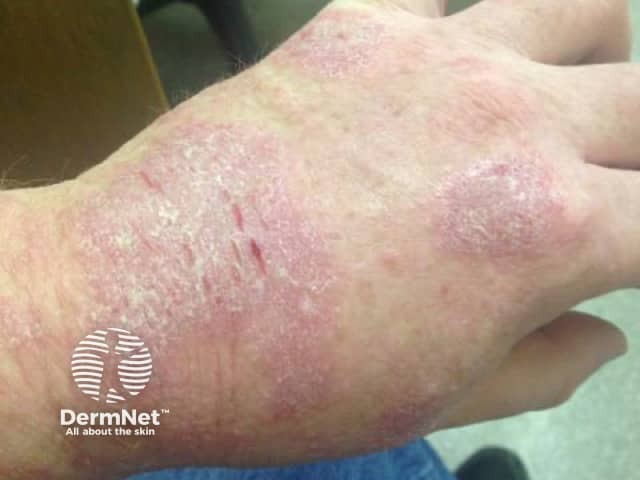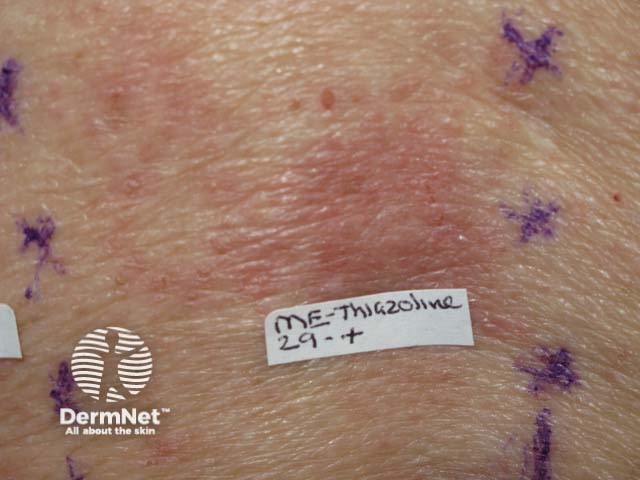Main menu
Common skin conditions

NEWS
Join DermNet PRO
Read more
Quick links
Methylisothiazolinone allergy — extra information
Methylisothiazolinone allergy
Author: Dr Lynne Gordon, Dermatologist, Adelaide, South Australia; Chief Editor: Dr Amanda Oakley, Dermatologist, Hamilton, New Zealand, 31 January 2016.
Introduction
Where is it found?
Prevalence
Demographics
Reactions
Diagnosis
Prevention
Treatment
Alternative names
Futher information
What is methylisothiazolinone?
Methylisothiazolinone (MI) is a preservative. MI was initially used occupationally, in paints, adhesives/glues and cleaners etc, as a mixture with methylchloroisothiazolinone (MCI). Since 2005, it has been widely used in cosmetics and household products, such as moist wipes, shampoos, cleaners and liquid laundry products.
When used in the industrial setting, MI was thought not to be a significant occupational allergen. Subsequently, following extensive domestic use, MI was found to be a strong allergen. It is responsible for an 'epidemic' of contact allergic dermatitis (2016). MI was named Contact Allergen of the Year 2013 by the American Contact Dermatitis Society.
Where is methylisothiazolinone found?
Products commonly containing methylisothiazolinone |
||
|---|---|---|
Pharmaceutical/self-hygiene products |
Household/industrial products |
|
Foundations/concealers |
Detergents/cleaners |
|
Bronzers/self-tanners |
Shampoo/conditioners |
Fabric softeners/ washing detergents |
Eye shadows |
Bubble baths |
Polishes |
Mascaras |
Soaps/hand washes/body washes |
Pesticides |
Make-up removers |
Baby wet wipes |
Paints |
Moisturisers |
Creams/lotions/gels |
Adhesives/glues |
Wet-wipe make-up remover/moist disposable wipes |
OTC and prescription medicines Wet-wipe moist personal hygiene cleaners, sunglass cleaners etc |
Latex emulsions Coolants Cooling tower water Pulp and paper industry |
ECG electrode gels |
Curing agents |
|
Jet fuels |
||
Printing inks |
||
Wet-wipe type cleaning products |
How common is an allergy to methylisothiazolinone?
Allergy to methylisothiazolinone is extremely common. The European Scientific Committee on Consumer Safety reviewed the literature and in July 2015 banned the use of MI in Europe in all-new leave-on products and lowered the concentration for rinse-off products; the concentration is now so low that it no longer functions as a preservative, and probably will not be used. This directive did not include industrial products.
The TGA is currently reviewing use in Australia. In 2015–16 in Australia and New Zealand, patch testing up to 20–25% of all patients tested to MI were positive.
Who is exposed to methylisothiazolinone?
There are two main situations in which people are exposed to MI.
- Personal hygiene “wet wipe” type products, such as baby wipes, personal hygiene wipes and cleaning wipes. This is due to the direct application of MI to the skin.
- Shampoos and liquid soaps; these are rinse-off products but may still result in contact dermatitis.
- The allergen MI is volatile, so it can also cause airborne contact dermatitis, for example:
- After house painting
- Using tiling glue
- Working or living/working in a freshly painted room.
What are the reactions to methylisothiazolinone?
Early on, dermatitis may occur only on part of the exposed skin. Common patterns include:
- Hand dermatitis
- Perianal dermatitis
- Perivulval dermatitis
- Napkin dermatitis
- Facial dermatitis
- Eyelid swelling
- Scalp dermatitis.
Later, more extensive and severe whole-body contact dermatitis may occur in very sensitive people.

Contact dermatitis due to methylisothiazolinone

Contact dermatitis due to methylisothiazolinone

Contact dermatitis due to methylisothiazolinone

Positive patch test to methylisothiazolinone
How is an allergy to methylisothiazolinone diagnosed?
Methylisothiazolinone allergy is diagnosed from the clinical history and by performing patch tests to MI and MCI/MI mix.
- MI is tested 0.2% in aqueous solution.
- MCI/MI is tested as a 0.01–0.02% mix in aqueous solution.
These are both included in the North American Baseline Series and the European Baseline Series.
Only MCI/MI is available in the True Test Kit and one study in 2015 from Bangkok demonstrated that 27% of those positive to MI would be missed if only MCI/MI mix in aqua was tested.
A positive patch test reaction to methylisothiazolinone may reflect a past exposure and may not be the cause of a current skin problem. However, as MI contact allergy is very common, it is generally relevant.
How can exposure to methylisothiazolinone be avoided?
Once MI or MCI/MI (isothiazolinone mix) sensitivity is confirmed, stop using all cosmetic and work products with this preservative. Tell your family doctor about your allergy.
It can be challenging to avoid MI and other isothiazolinones, as they are in many cosmetic products. Read product labels carefully; they are generally listed towards the end of the ingredient list. Do not use unlabelled products. Brand name or packaging of products can be very similar, however, the preservatives may be different. Products within the same brand often contain different preservatives (eg hair shampoos, conditioners, baby wipes, face creams etc). For example:
- Dettol (original) contains chloroxylenol
- Dettol hand sanitiser contains methylisothiazolinone
- Dettol surface cleanser contains benzalkonium chloride.
If unsure, ask your pharmacist or dermatologist for advice or a suitable alternative. Be aware that contact allergy can also occur to other preservatives.
It is also important to avoid exposure to methylisothiazolinone preservative or related preservatives in the workplace.
- Inform your employer about your allergy.
- Identify potential sources of exposure using Material Safety Data Sheets; these are required for all chemicals and substances in the workplace.
- Note that Material Data Sheets often do not fully list all components.
Highly sensitive people may need to avoid freshly painted rooms for up to 4 weeks.
Cross-reactions
All chemicals in the isothiazolinone group may cross-react and need to be avoided.
Other preservatives can also cause contact allergy.
Self-testing
Self-testing a product for MI is possible but should be done only after first talking with your dermatologist. An open application test should be done only with products that are designed to stay on the skin such as cosmetics (not including eyeliners or mascaras) and lotions.
- Apply a small amount of the product to a small area of skin such as elbow crease twice a day for 3 weeks.
- Examine the area each day
- If no reaction occurs, the product is probably suitable for you to use. Even so, you should still be cautious if you are intending to use it over large areas
Products such as shampoos, soaps and cleansers should not be self-tested, as they contain detergent that may cause irritant contact dermatitis on tender areas of skin in anyone.
Treatment of contact dermatitis due to methylisothiazolinone
People diagnosed with methylisothiazolinone allergy should avoid exposure to all isothiazolinone mix-containing products.
Treatment of contact dermatitis includes:
The labels of treatment creams should also be inspected, to ensure they do not contain isothiazolinone preservatives.
People with severe MI contact dermatitis may require oral corticosteroids.
Alternative names for isothiazolinones
- Trade names for MCI/MI include Kathon®, Kathon CG®, Kathon 886®Euxyl K100, Acticide, Algucid, Algucid CH 50, Amerstat 250, GR 856,Groton TK2, Metatin GT, Mitco CC, Mx 323 Parmetol. This list is incomplete.
- Methychloroisothiazolinone (MCI)
- Methylisothiazolinone(MI)
Futher information
CAS number
- Kathon (55965-84-9)
- 2-methyl-4-isothiazolin-3-one (2682-20-4)
- 5-chloro-2-methyl-4-isothiazolin-3-one (26172-55-4)
Sensitiser
- 2-methyl-4-isothiazolin-3-one (strong sensitiser)
- 5-chloro-2-methyl-4-isothiazolin-3-one (strong sensitiser)
Patch test
- Isothiazolinone mix 0.01–0.02% (MCI/MI) in aqueous solution
- Methylisothiazolinone 0.2% in aqueous solution
References
- Book: Contact Dermatitis 5th ed.. Ed Johansen JD, Frosch PJ, Lepoittevin J-P, Springer 2011.
- Book: Fisher’s Contact Dermatitis. 6th ed. Ed Rietschel.RL, Fowler JF, Lippincott Williams & Wilkins 2008
- Patchcams; Occupational Dermatology Research and Educational Centre, Skin and Cancer Foundation Inc. Victoria
- Schwensen JF, Uter W, Bruze M, Svedman C, Goossens A, Wilkinson M, Giménez Arnau A, Gonçalo M, Andersen KE, Paulsen E, Agner T, Foti C, Aalto-Korte K, McFadden J, White I, Johansen JD; European Environmental Contact Dermatitis Research Group. The epidemic of methylisothiazolinone: a European prospective study. Contact Dermatitis. 2017 May;76(5):272-279. doi:10.1111/cod.12733. Epub 2016 Dec 28. PubMed PMID: 28032337. PubMed.
On DermNet
- Dermatitis
- Allergic contact dermatitis
- Patch testing
- Preservative allergy
- Cosmetics
- Occupational dermatoses
- Baseline series of patch test allergens
Other websites
- T.R.U.E. Tests
- Allergy New Zealand
- Methylchloroisothiazolinone – Household products database, US Department of Health & Human Services
- Occupational Dermatology Research and Education Centre
- Methylisothiazolinone Free — Methylisothiazolinone and methylchloroisothiazolinone allergy — news, information and support
